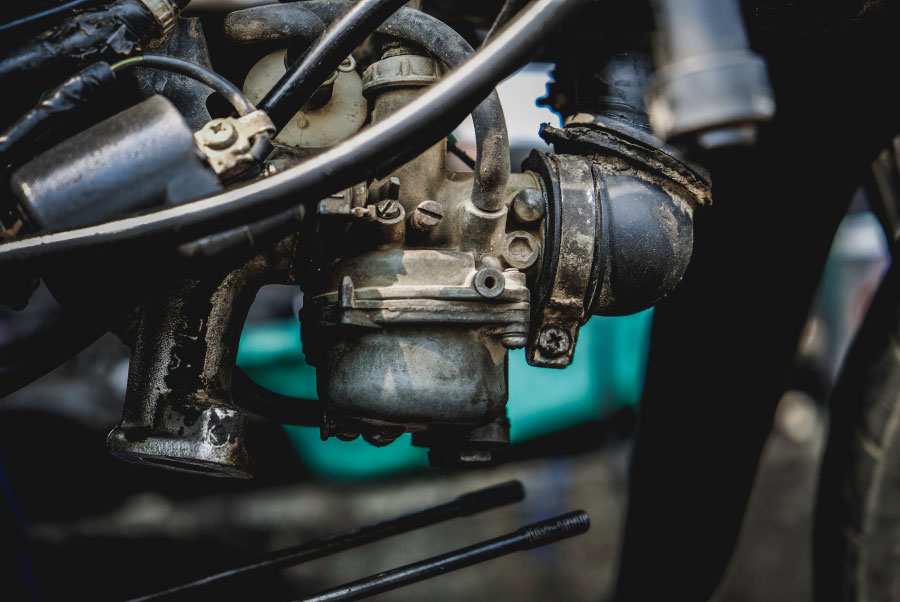
Carburetors and fuel injectors are both systems of getting the fuel-air mixture to the engine cylinders for combustion. The carburetor has been around for many years and uses the venturi principle in conjunction with valves to deliver the fuel mixture.
The Electronic Fuel Injection system has started replacing carburetors as the fuel delivery method of choice by most dirt bike manufacturers. If you have a dirt bike that uses a carburetor, is it possible to convert to fuel injection, how would you achieve it, and would you want to convert?
The best way to convert a carburetor to fuel injection on a dirt bike is to use an electronic Fuel Injection or EFI kit. Once the right conversion kit is identified and you have all the right parts, get access to the carburetor, connect EFI to power, install the sensors, the fuel pump, and connect all the lines.
While the idea of a kit to convert your dirt bike fuel delivery system sounds like a great idea, it is not quite as straight forward as that. We discuss the detail of the conversion below and also some reasons you may not want to convert your bike in this way.
How To Do The Conversion From Carburetor to Fuel Injection
Carburetors have been the standard method of fuel delivery to the combustion chamber of most engines, including dirt bikes, for decades. The development of computers and electronics has, in the new millennium, seen the increased use of electronic fuel injectors in most engines, including those of dirt bikes.
Most dirt bike manufacturers have adopted this technology in their newer model bikes, but some of them still offer carburetor fueled models as well. If you ride an older dirt bike, it will most likely have a carburetor, as that was the only method around at the time for fuel delivery.
We will cover the 7 basic steps you need to follow if you are looking to convert your dirt bike from carb to an EFI system. These will not be detailed steps, as the detail fitment will differ from bike to bike and kit to kit.
Fuel injection kit
Source your electronic fuel injection kit is step one in the process. You will need to do a fair amount of research into which kit is compatible with your bike. Much of the difference will be in the design of the throttle housing, which will determine compatibility.
Parts
The second step is to check the installation manual carefully to make sure you have all the parts and any extra parts and tools the instructions recommend for the installation.
Preparation
The third step is to prepare the bike for the conversion. To get access to the carburetor and connections, you will probably need to remove the seat and, in some cases, the fuel tank. If you don’t need to remove the fuel tank, make sure the fuel tap is turned to the off position. Remove the fuel pump and any fuel lines attached.
Connection
The EFI kit will come with an ECU, which is a mini-computer that controls the fuel injection. To connect this to power, you will need to find the main ignition power cable in the bikes wiring harness and attach a connector to it that came with the kit. You will connect the ECU to this plug. This is the fourth step.
Sensors
The fifth step is to install the various sensors that the kit requires. This will usually be an air sensor on the cylinder or the number one cylinder and air sensors and throttle position sensors in locations as specified by the kit instructions. Connect the sensor cables to the ECU and mount the ECU with the bracket provided.
Fuel pump
Install the fuel pump shipped with the kit and connect the fuel lines and throttle connections, which will complete the sixth step.
Fuel lines
The seventh and final step would be to connect all the fuel lines and throttle cable, connect and refit the fuel tank and seat, and the battery cables.
The fitment would be completed once these steps have been followed, and all that would remain would be to tune the EFI. This is usually done by connecting the ECU unit to a laptop computer via the supplied port and using the software provided with the kit to perform the tuning.

What Are The Differences Between Fuel Injection And A Carburetor?
A carburetor is not a complicated piece of technology and has been used for decades in combustion engines. It uses physics principles to mix air and fuel before delivery to the combustion chamber of the motor. Tuning a carburetor can be done by anyone with basic knowledge of how it works. Adjustment of a carburetor is achieved by balancing the fuel-air mixture via adjustment of the valves that control the fuel-air mixture.
These adjustments will change whether the motor is running lean with not enough fuel or rich with too much fuel in the mix. The ideal setting is a balance of these two components to get the motor running to get the engine running as smoothly and efficiently. These adjustments are made manually by restricting or opening the relevant valve adjustment screws.
In a fuel injection system, this process of tuning the mixture is computerized. This results in much finer and more accurate adjustments to the mixture. The result is that the fuel is burned more efficiently, the engine runs more optimally and results in more power from the motor. There is also a fuel-saving aspect, as the fuel is used more efficiently in the engine.
This additional power is mostly the motivation behind dirt bike riders wanting to convert their carbs to an EFI system.
Why You May Not Want To Convert To Fuel Injection!
The quest for additional power via installing a fuel injection system on your dirt bike comes with some disadvantages. You may want to consider the downside to this conversion to determine if the trade-off is worth your while and is something you want to pursue.
Here are some of the potential hazards of installing an aftermarket fuel injection system in place of a carburetor on your bike.
- Aftermarket EFI kits are manufactured to fit various dirt bikes. If you do not get a quality kit, you are more than likely going to run into compatibility issues where the kit does quite fit right. You may be tempted to “make it work,” but this is not ideal and will probably lead to more frustration than the benefits you expected to get from the EFI kit.
- Fitment of the kit is not for the inexperienced. If you have never done any tuning of electronic fuel injection systems, you may find it to be a challenge that is beyond your skill level. These kits are not recommended as DIY fitment projects to be done in your home garage! You will probably need to get a professional to do the installation for you. This increases the cost, as it is usually a specialist who will perform the conversion and tuning.
- Dirt bike riders often like to tune their bikes on the fly, at the track to adjust for altitude and other race conditions. With a carburetor, the adjustment is simple, and all you would need in the way of tools is a screwdriver to turn the adjustment screws, nice and simple. An electronic fuel injection system, on the other hand, needs to be hooked up to a computer, and someone with expert knowledge of the software and tuning will be required to fine-tune the EFI. For many dirt bike riders, the complication of tuning an electronic fuel injection is a downside to the system, and they would rather retain the ability to tweak their bike performance themselves.
- The cost of the conversion could be another factor that may change your mind, depending on your bike. If your bike is old and is valued at under $2000, it may not be worth the cost to perform the conversion to EFI. The cost of the conversion can run to over the $2000 mark. In this case, it would make more financial sense to sell your old bike and buy a newer model that comes standard with electronic fuel injection.
Conclusion
As you can see, performing the conversion from a card powered dirt bike to fuel injection is not always the right thing to do. You will need to evaluate your bike, your racing goals, and your budget to decide if the project is going to bring sufficient enhancement to your bike’s performance to be of benefit to you.
Happy dirt biking!


